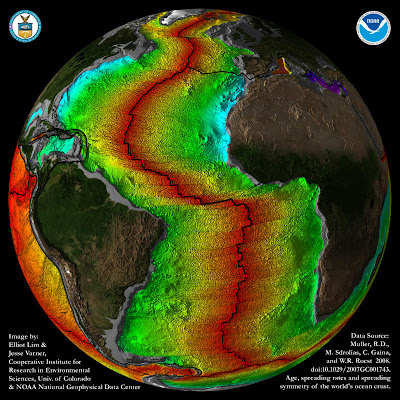New 'embryonic' subduction zone found
E' stata scoperta una nuova zona di subduzione, che si sta formando al largo della costa del Portogallo: essa annuncia l'inizio di un ciclo che vedrà alla fine chiudersi l'Oceano Atlantico, con il riavvicinarsi.
A new subduction zone forming off the coast of Portugal heralds the beginning of a cycle that will see the Atlantic Ocean close as continental Europe moves closer to America.
Published in Geology, new research led by Monash University geologists has detected the first evidence that a passive margin in the Atlantic ocean is becoming active. Subduction zones, such as the one beginning near Iberia, are areas where one of the tectonic plates that cover Earth's surface dives beneath another plate into the mantle -- the layer just below the crust.
 |
| NOAA/NGDC image of the Atlantic crustal age of the ocean floor. Geologists have detected the first evidence that a passive margin in the Atlantic ocean is becoming active. The team mapped the ocean floor and found it was beginning to fracture, indicating tectonic activity around the apparently passive South West Iberia plate margin [Credit: Mr. Elliot Lim and Mr. Jesse Varner, CIRES & NOAA/NGDC]
Il nuovo lavoro dei ricercatori della Monash University è stato pubblicato sulla rivista Geology, ed evidenzia per la prima volta l'attivarsi di un margine passivo nell' Oceano Atlantico. Le aree di subduzione, come quella che sta cominciando ad agire presso la penisola Iberica, sono quelle in cui le placche tettoniche che costituiscono la superficie terrestre si affondano al di sotto di un'altra placca entrando nel mantello, al di sotto della crosta. Il risultato, in superficie, è osservabile (in tempi 'geologici') come l'avvicinamento dei continenti.
|
Primo autore è il Dr João Duarte, della Scuola di Geoscienze, che sostiene che la sua equipe ha eseguito una mappatura del fondo oceanico ed ha reperito l'inizio di una frattura, indicante la presenza di attività tettonica presso il margine apparentemente passivo del bordo della placca Iberica sud occidentale. Una zona di subduzione "allo stato embrionale".
Lead author Dr João Duarte, from the School of Geosciences said the team mapped the ocean floor and found it was beginning to fracture, indicating tectonic activity around the apparently passive South West Iberia plate margin.
"What we have detected is the very beginnings of an active margin -- it's like an embryonic subduction zone," Dr Duarte said.
L'attività sismica significante, incluso il terremoto del 1775 che devastò Lisbona, indicherebbe che esiste una convergenza di attività sismica in quest'area. Per la prima volta, si è riusciti non solo a dimostrare che questo è effettivamente il fenomeno in corso, ma anche quali ne siano le cause intrinseche.
"Significant earthquake activity, including the 1755 quake which devastated Lisbon, indicated that there might be convergent tectonic movement in the area. For the first time, we have been able to provide not only evidences that this is indeed the case, but also a consistent driving mechanism."
"Significant earthquake activity, including the 1755 quake which devastated Lisbon, indicated that there might be convergent tectonic movement in the area. For the first time, we have been able to provide not only evidences that this is indeed the case, but also a consistent driving mechanism."
L'iniziale subduzione nella zona Iberica potrebbe segnalare l'inizio di una nuova fase nel cosiddetto Ciclo di Wilson, per cui i movimenti delle placche frammentano i supercontinenti come Pangea, aprono nuovi oceani, si stabilizzano, infine formano nuove zone di subduzione che richiudono gli oceani e riportano insieme i continenti.
The incipient subduction in the Iberian zone could signal the start of a new phase of the Wilson Cycle -- where plate movements break up supercontinents, like Pangaea, and open oceans, stabilise and then form new subduction zones which close the oceans and bring the scattered continents back together.
The incipient subduction in the Iberian zone could signal the start of a new phase of the Wilson Cycle -- where plate movements break up supercontinents, like Pangaea, and open oceans, stabilise and then form new subduction zones which close the oceans and bring the scattered continents back together.
Questo processo di frammentazione e ricompattazione è avvenuto almeno tre volte, più di 4 miliardi di anni fa, sulla Terra. L'avvicinamento dell'Iberia agli attuali Stati Uniti richiederà approssimativamente 220 milioni di anni.
This break-up and reformation of supercontinents has happened at least three times, over more than four billion years, on Earth. The Iberian subduction will gradually pull Iberia towards the United States over approximately 220 million years.
La possibilità di studiare il fenomeno dell'attivazione di un margine passivo - anche se si tratta di un processo lentissimo che richiederà circa 20 milioni di anni - permetterà di ottenere nuovi ed interessantissimi dati , cruciali per la migliore comprensione dei modelli geodinamici.
This break-up and reformation of supercontinents has happened at least three times, over more than four billion years, on Earth. The Iberian subduction will gradually pull Iberia towards the United States over approximately 220 million years.
La possibilità di studiare il fenomeno dell'attivazione di un margine passivo - anche se si tratta di un processo lentissimo che richiederà circa 20 milioni di anni - permetterà di ottenere nuovi ed interessantissimi dati , cruciali per la migliore comprensione dei modelli geodinamici.
The findings provide a unique opportunity to observe a passive margin becoming active -- a process that will take around 20 million years. Even at this early phase the site will yield data that is crucial to refining the geodynamic models.
"Understanding these processes will certainly provide new insights on how subduction zones may have initiated in the past and how oceans start to close," Dr Duarte said.
Source: Monash University [June 17, 2013]
"Understanding these processes will certainly provide new insights on how subduction zones may have initiated in the past and how oceans start to close," Dr Duarte said.
Source: Monash University [June 17, 2013]